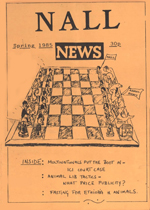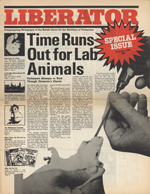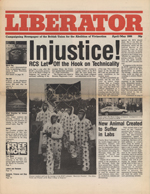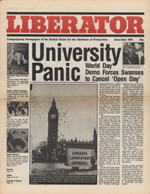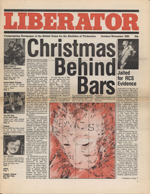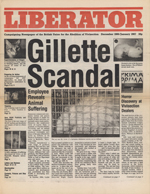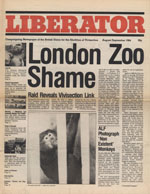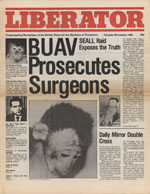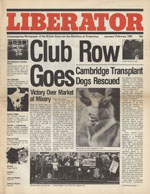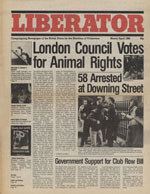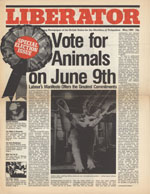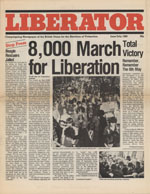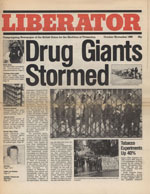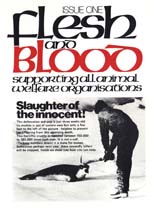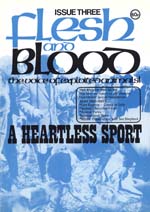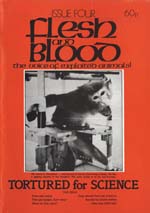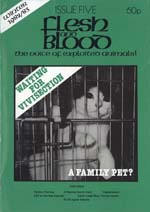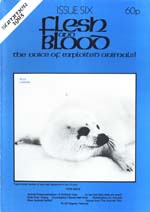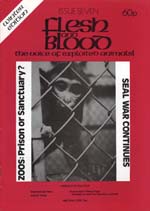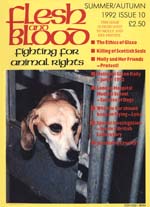The Archives
-
Campaign newsletters, Periodicals
N.A.L.L. Newsletters – Summer and Spring 1985
03.26.15 | PermalinkN.A.L.L. Newsletter – Summer 1985, Spring News 1985 (1985, Manchester, England)
Every time we receive a NALL related donation everyone at TALON can’t wait to read it, even if it is just a small newsletter or leaflet. Our fascination with the group stems from their early socialism, their insistence that mass-militancy trumps individual direct-action, and their acts of solidarity with other movements. While their publications don’t always touch on those factors, fans of the Leagues will not be disappointed with these two issues of the NALL Newsletter, especially the Spring News, which comments on the unstrategic militarism happening at the time, specifically the Mars bar poisoning hoax and publicity stunts of groups like the Hunt Retribution Squad.
The excitement doesn’t end there, however! Despite the poor editing, these volumes contain many clues as to the organizing model, rhetoric, history, and strategies employed by NALL- and then there are the small tidbits that will make you love them even more! An embracing of ecological politics, a tendency towards anonymity for the sake of rejecting the big egos that cause so much damage to movements, the fact that NALL was originally called Manchester Animal Liberators, the mention of a cafe run by three NALL members… If you are as fascinated with this classic organization as we are you will absolutely love these two dispatches!
…
-
BUAV Liberator, Most Popular
BUAV Liberator 1986
10.15.14 | PermalinkBUAV Liberator (1986. London, England)
“Although the BUAV as a limited company can only organize legal activity, we aim to complement and support direct action whenever possible.” BUAV editorial, April-May 1986
Frequent readers of the site will be aware that TALON’s volunteers are big fans of the BUAV Liberator. Not only do its old pulp pages bleed with animal lib history, but the politics represented by BUAV at that time were among the most progressive (and occasionally radical) of any major national non-profit working for non-humans.
During this era the British Union to Abolish Vivisection supported any direct action which did not include pre-meditated violence towards a human, and proudly advocated a broad array of strategies and tactics. From letter writing to sabotage, legislation to arson, the BUAV gave coverage to nearly all of the activism in England at the time- and that is only a small part of what makes these papers so great.
Year after year, each volume of the Liberator gives us clues as to the mood within the movement. In 1986 for example, we see a somber tone set over the movement as the Liberation League’s began to fold, the government passed legislation expanding vivisection, and dozens of activists began prison sentences over lab raids. This blow to activist morale in 1986 was perhaps most visible in the actions of Robert Blackman, a young man who entered the Colchester cattle market and self immolated to protest the sell of living beings. His mother later said that “He gave his life because he thought the cruelty would never stop.”
Interestingly, 1986 was also a year filled with inspiring actions for animals. Issue after issue details labs shut down, vivisectors ending their careers, a dramatic rise in veganism and vegetarianism among the general public, and non-humans having their first taste of freedom. It is only within the context of the meteoric rise of animal rights in the earlier part of the 1980s could this year be seen as any kind of a failure. Indeed, if the level of activism in these issues were to occur today morale would sky rocket and great breakthroughs could be made- and all of us should take that as a challenge!
…
-
BUAV Liberator, Periodicals
BUAV Liberator 1984
12.25.13 | PermalinkBUAV Liberator (1984. London, England)
As our holiday gift to you we present the complete 1984 volume of BUAV’s Liberator. This classic publication comes from an optimistic time in our movement when national non-profits were still working with radicals, articles about legislative efforts ran alongside tales of lab break ins, and the struggle for non-human liberation was growing by leaps and bounds. We love this newspaper, and hope that it reminds all of you in the trenches that we are strongest when we work together.
(Editor’s note: When we originally published this post we mistakenly missed the December 84/ January 85 edition. We apologize for the error and have now included the missing issue in our archive.)
…
-
BUAV Liberator, Periodicals
BUAV Liberator – 1983
07.16.13 | PermalinkBUAV Liberator (1983. London, England)
The British Union for the Abolition of Vivisection was first established in 1898 by the Irish feminist Frances Power Cobbe. In its long history it has rarely been effective as a fighting force for non-humans, but every so often the organization has a flash of brilliance. In the 1980s, sparked to greater militancy by an explosion of youth activism against vivisection, one of these “flashes” became a conflagration that lasted more than five years.
After shedding their corporate image for something with a little more edge, the BUAV’s publication, “Liberator” became the most important publication during England’s rise of animal lib militancy. While the legislative and educational work of the Union continued, they also incorporated support for direct action. The results were spectacular. Mainstream acceptance of the underground increased, protests grew in size, more people began directly saving non-humans from places of abuse, the grassroots expanded, and unity across the tactical spectrum meant less infighting and more progress for all parties involved.
As always, marriages between moderates and radicals are unstable, and like many others this one ended in a bitter divorce. The BUAV kicked Ronnie Lee’s ALF Press Office out of their building, the SG denounced BUAV as do-nothing liberals, and direct action became harder to support as groups like ARM started sending postal bombs. Still, it was a productive relationship while it lasted, and these newspapers provide an interesting look into just what a national organization for animals can accomplish.
…
-
Periodicals
Flesh and Blood
04.25.13 | PermalinkFlesh and Blood #1-8 and 10 (1980-1992 – Hertfordshire, England)
Flesh and Blood was a long running, journal sized magazine with high production values. Each issue featured a color cover printed on heavy, full gloss cardstock, and brief articles with information about animal rights campaigns. It’s appearance and tone was quite mainstream, but many issues showed support for illegal direct action. This was, perhaps, Flesh and Blood’s greatest strength: it refused to split activists along standard radical / moderate / conservative lines, and instead showed measured support for everyone in the struggle.
We are seeking more information about this publication, including the number of issues published. We are also in need of issue #9, which relaunched the publication after its demise in the early 80s. If you can assist us, please use the contact form available HERE.
…
-
Most Popular, Periodicals, The Beast
The Beast #1-#10
03.29.12 | PermalinkThe Beast #1-#10 (1979-1981. London, England.)
On the 5th of November of 1947 a baby lowland gorilla, stolen from his home and family in West Africa, arrived at the London Zoo. As it was Guy Fawkes day, this newest prisoner was named in his honor. Guy the Gorilla went on to become one of the biggest money makers for his captors, and thousands of visitors would gawk at him, occasionally throwing him sweets to eat. Eventually the candies rotted his teeth, and during a surgery to repair them, he had a heart attack. The budding animal liberation movement in the UK took notice, and a group of people began producing buttons with Guy’s face on them. As the buttons grew in popularity, this small group decided to make a newspaper, and soon The Beast became an insert in International Times. After two such inserts the editors struck out on their own, and soon this beautiful publication was on newsstand racks in England and abroad. It was produced for two short years, and remains one of the best animal liberation (and anti-nuke!) publications of all time.
The Beast began it’s run during a time of global social and political decay. As the voters of the west fell under the spell of charismatic and brutal conservatives, a broad coalition of anti-nuke, anti-fascist, union, conservationist, environmentalist, and animal lib activists entrenched themselves to fight back. As things “hotted up” in the streets, the staff of the magazine followed the action and ideas of an astonishing number of people and groups. The tone in the early issues is optimistic, brave, and intelligent, and offers a fascinating glimpse into the psyche of activists during the era.
The history covered is equally incredible. Articles offer the story of the first animal liberation raid in the United States, the origins of the Hunt Saboteurs Association, and the early days of the Animal Liberation Front. Lost figures, like OG U.S. Hunt Sab and eco-prisoner John Walker, come back to life in these old pages. Important thinkers, such as Henry Spira, Peter Singer, Richard Adams, and Paul Watson were regular contributors. Then, there are the images! Between the full color, glossy covers are amazing pictures of early raids, movement legends, and epic moments on our movement’s timeline. One such photograph, taken in 1980 and shown in issue #10, captures a small group of Animal Liberation League activists standing with banners in a field, bandannas covering their faces, fists in the air. More than 30 years later young people still show that same spark of rebellion and hope, and with our archiving of this magazine, perhaps they will now better understand the revolutionaries who came before them.
When we started Conflict Gypsy one of our dreams was to obtain a complete set of The Beast. After just one year of existence, we have met this goal. As our birthday gift to you we offer the Complete Newsstand Collection of The Beast, perhaps our most important single posting so far…











